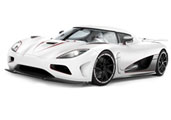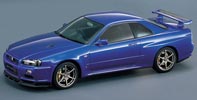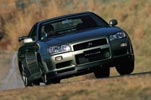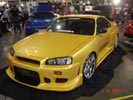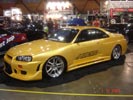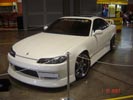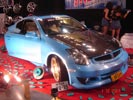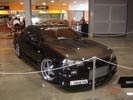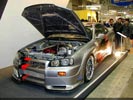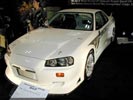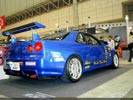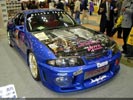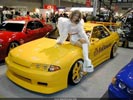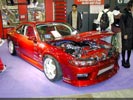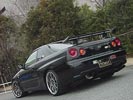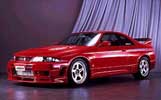The Nissan Skyline is a mid-size car originally produced by the Japanese automaker Prince Motor Company starting in 1957 and later by Nissan after the two companies merged in 1966.
R31 GTS-R
The R31 Skyline of 1986 was a natural evolution on the R30 shape. The ultimate version of the R31 was the RB20DET-R powered HR31 GTS-R Coupe (800 units built for group A evolution). It had a reworked version of the normal RB20DET with a much larger turbocharger on a tubular steel exhaust manifold, as well as a much larger front mounted intercooler boosting power to a factory claimed 210 ps (154 kW), with racing versions making 460 hp (343 kW) in Group A trim.
The HCR32 Skyline debuted in May 1989. It was available as either a 2-door coupe or 4-door sedan/saloon, all other bodystyles were dropped.
R32 GTR
The GT-R returned with twin ceramic turbochargers, all-wheel steering, all wheel drive, and 280 hp (206 kW) at 6800 rpm. The RB26DETT engine actually produced ~320 hp, but it was unstated due to the Japanese car makers' "gentlemen's agreement" not to exceed 206 kW (276 hp). The engine was designed for ~500 hp in racing trim,[3] and then muzzled by the exhaust, boost restriction, and ECU. A Nissan Skyline is capable straight off the market to have 188 kW and reaches 0-100 km/h in 6.2 seconds and 1/4 mile in aprox 15.0 seconds with manual transmission. The electronic boost control had a small physical restriction in the control lines. It was marked in yellow so the new owner could remove it and enjoy a safe factory boost increase. After this increase the Car would put out ~320 hp and could do 0-100 km/h in 4.7seconds and quarter mile in 12.8 seconds.[4] The GT-R had Super HICAS, a more advanced computer controlled four wheel steering system using electric actuators.
The GT-R had a significantly larger intercooler, larger brakes, and aluminum front guards and bonnet. Other distinguishing features include flared front and rear wheel arches. More supportive seats were fitted, and the turbo boost gauge and digital clock were removed from inside the instrument cluster. The clock was replaced with a torque meter that indicated how much torque was being delivered to the front wheels (0%-50%). Oil temp, voltage and turbo boost gauges were fitted below the climate control.
The Porsche 959 was Nissan's target when designing the GT-R. The chief engineer, Naganori Itoh, intended to use the car for Group A racing, so the design specification was drawn up in conjunction with a copy of the Group A rules.
R33 GTR
he R33 Skyline (Series 2) continued the concepts introduced in the R32. Drivers airbags became standard in 1996 as they had been only an option up until this time, passenger side airbags remained an option. For the RB25DET engine the ignition system was also changed, with the ignition module no longer located on the cam covers and was instead replaced by smart ignition coils (Ignitor built into coil) and ECU. The RB25DET turbo was also given a nylon compressor wheel.
The BCNR33 GT-R version also had the same RB26DETT engine that the BNR32 was equipped with, although torque had been improved, due to changes in the turbo compressor aerodynamics, turbo dump pipe, and intercooler. The turbo core changed from a sleeve bearing to a ball bearing, but the turbine itself remained ceramic, except on N1 turbos (steel turbine, sleeve bearing). From the R33 onward, all GT-Rs received Brembo brakes. 1995 saw the GT-R get an improved version of the RB26DETT, the ATTESA-ETS all wheel drive system, and Super HICAS all-wheel steering. A limited edition model was created in 1996, called the NISMO 400R, that produced 400 hp (298 kW).A stronger six speed Getrag gearbox was used. An R33 GT-R driven by Dirk Schoysman lapped the [Nürburgring|Nordschleife]] in less than 8 minutes. Though it was often said to be the first production car to break 8 minutes, the limited run Jaguar XJ220 had already achieved a 7'46" lap. Other manufacturers had caught up since the R32 was released, and the R33 never dominated motorsport to the extent of the R32.
R34 GTR
In May 1998 the HR/ER/BNR34 addressed many of the concerns over the change from the R32 to the R33, with more emphasis on sportiness, and marked the introduction of the more fuel efficient and environmentally friendly RB25DET NEO engine. The RB20E engine was discontinued in the R34 base model (GT), and the RB20DE, after last being used in the R32 Skyline, was reintroduced in updated NEO guise. The R34 GT powered by the RB20DE NEO, coupled with a 5 speed gearbox, became the most fuel efficient straight six Skyline to date (of any shape). It was not the most fuel efficient straight six of its time though; the 1998 Toyota Supra had better reported fuel economy. The 5 speed automatic transmission available on some models in the previous 2 shapes were discontinued. In its place Nissan produced a 4 speed tiptronic transmission for all of the automatic versions.
The GT-R reappeared in 1999, with a revised chassis and other updates. The R34 turbos received a ball bearing core. The R34 N1 turbos had a metal exhaust wheel, and ball bearing center section. A stronger six speed Getrag gearbox was used. The turbo outlet pipes were changed from cast to formed metal outlets. The intercooler had a temperature probe in the V-spec models.
GT-R NISMO Z-tune - 2.8 L (bored and stroked) RB26DETT Z2 twin-turbo I6, 500 PS (368 kW, 540 N m) Z1 and Z2 (Only 20 made).
R35 GTR
The new GT-R (R35) was never officially named Skyline but is known as the successor to the Skyline GT-R. It was released in Japan on 24 October 2007 at the Tokyo Motor Show. It is expected to be released internationally during 2008 as a 2009 model. It was revealed at the Tokyo Motor Show, following the leak of the December issue of MotorTrend magazine that covered the future release of the model. Bearing a high resemblance to the Nissan GT-R Proto, the new GT-R keeps a shape that still bears the traits of its predecessors, but loses the "Skyline" moniker officially. The new GT-R is equipped with the new VR38DETT V6 twin turbo engine, breaking a 35 year old tradition of putting inline-sixes in GT-R models. The new GT-R still keeps certain technologies that made it famous, like an updated version of the ATTESA-ETS. The new R35 will be the first GT-R to be in production for the United States. The new GT-R has also had a big success in Japanese racing series, then as the racing model the GT-R GT500.
Car - Nissan Skyline
Copyright © 1998-2013 you.com.au

